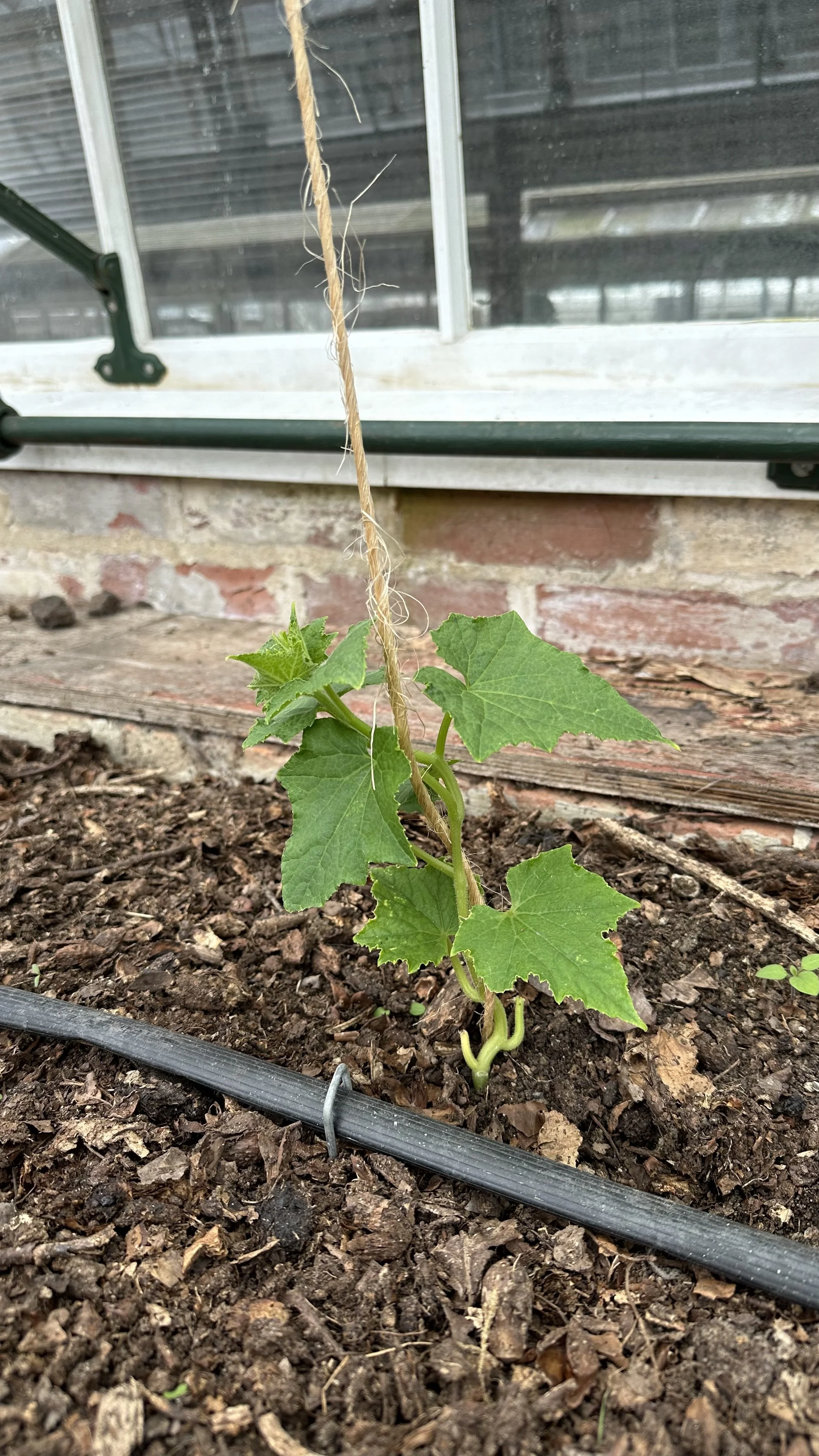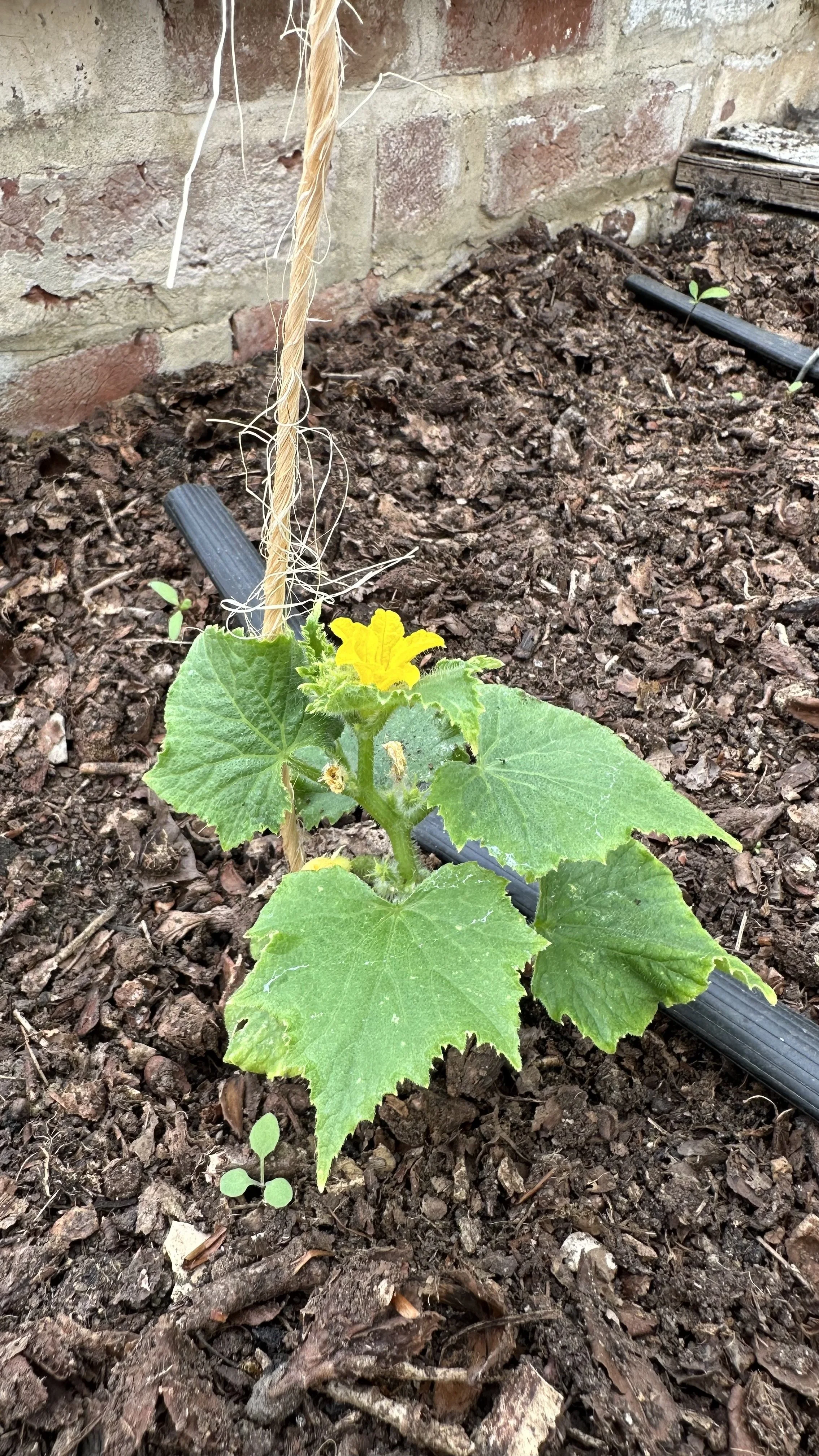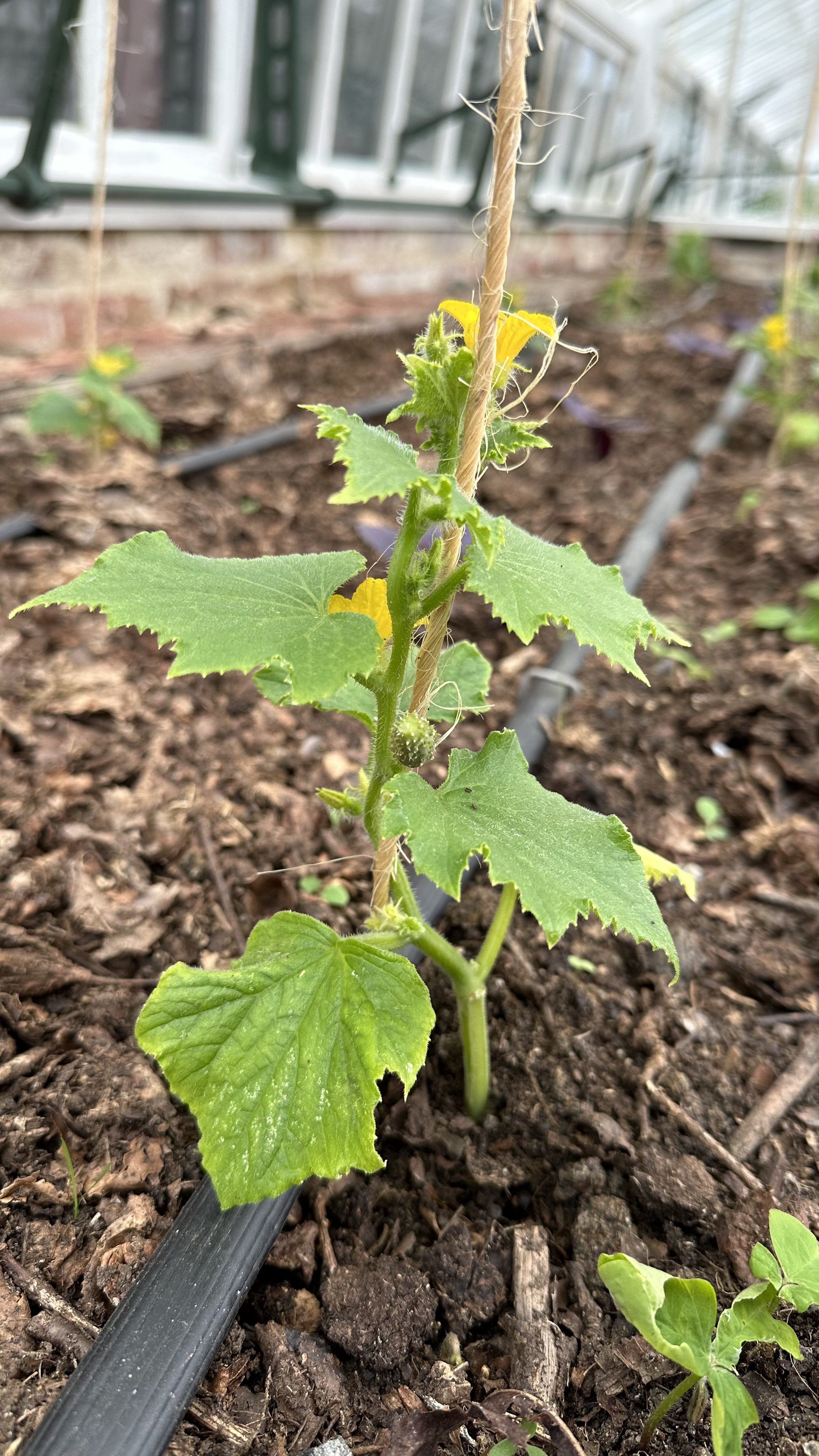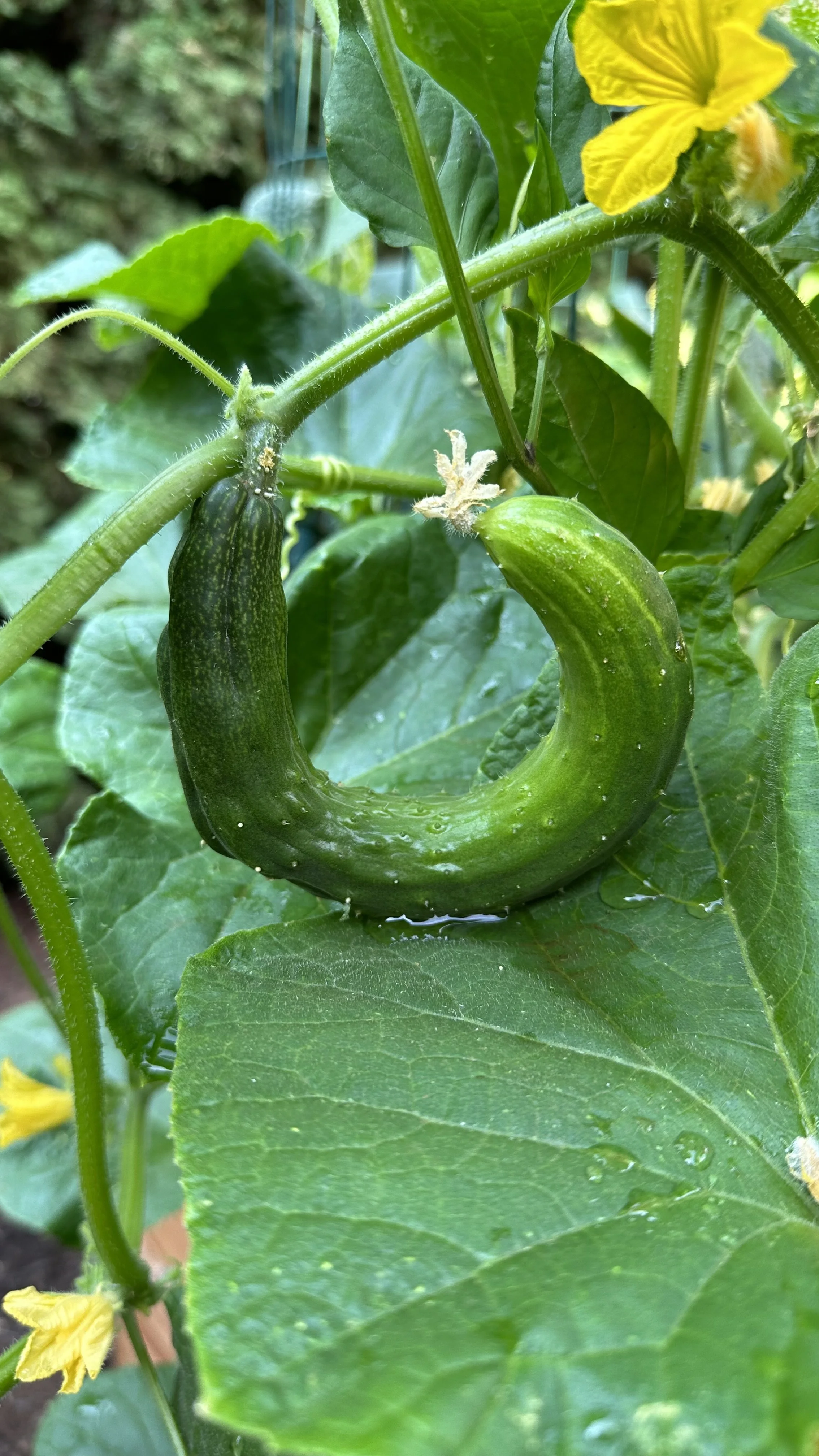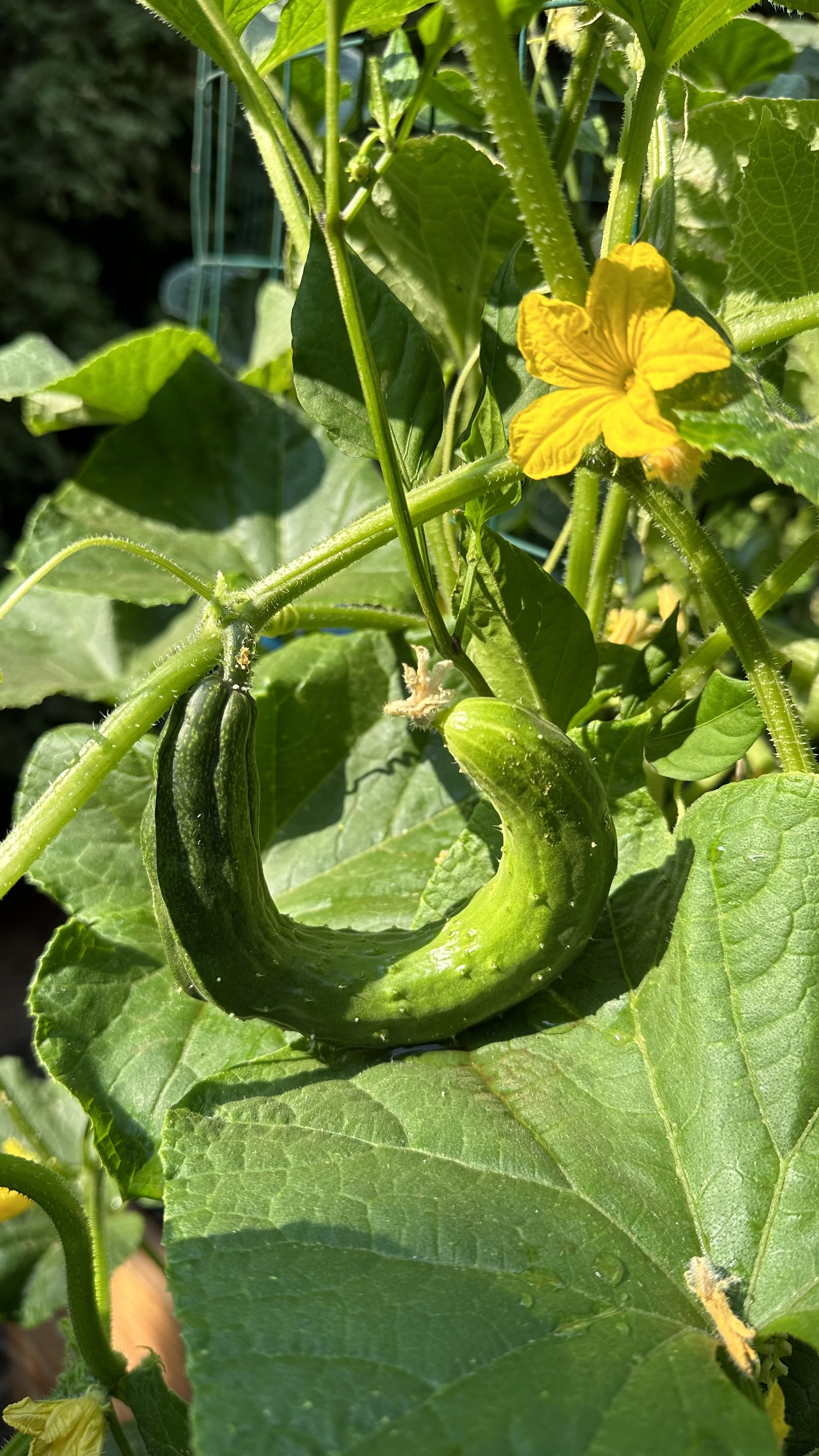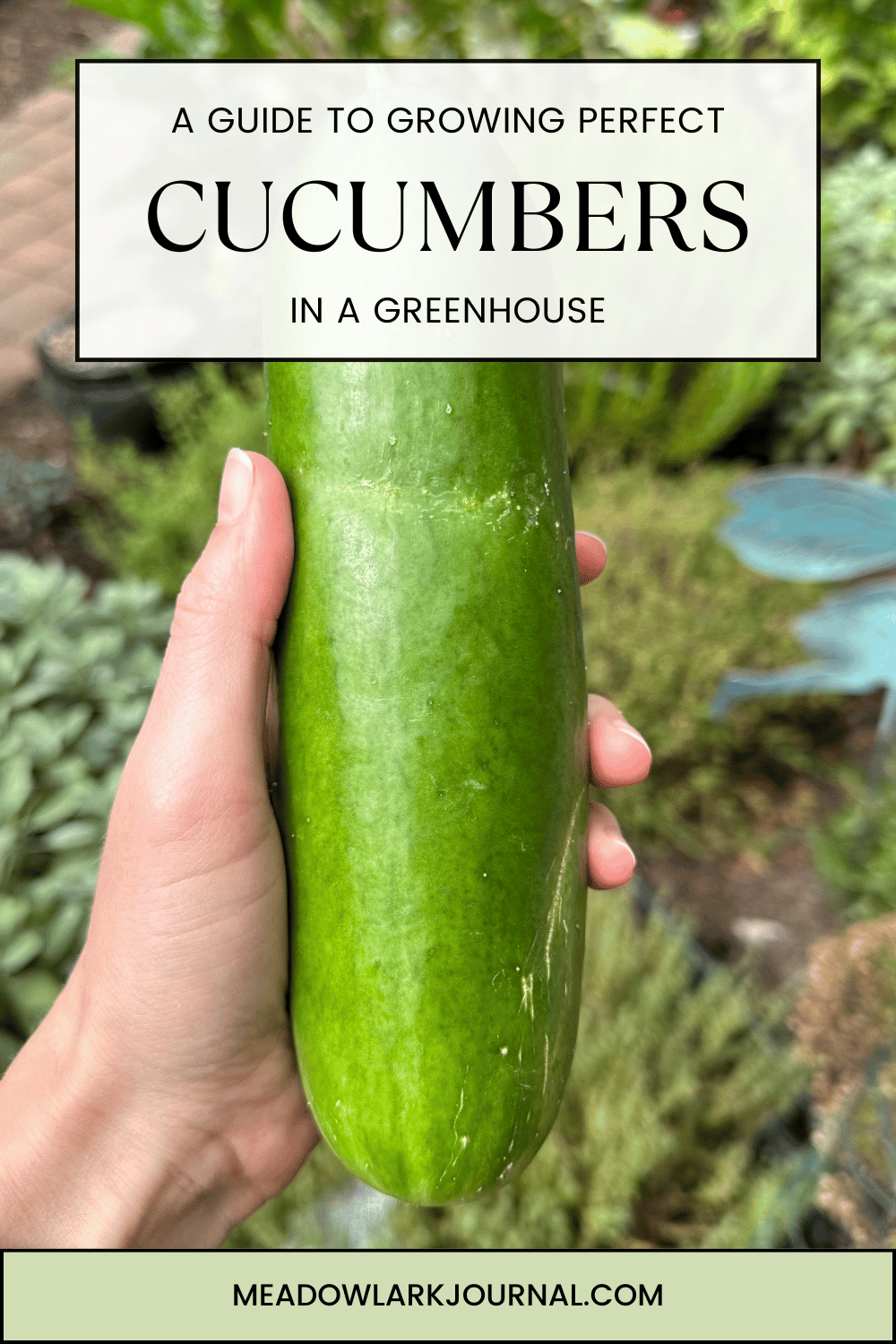A Guide to Growing Perfect Greenhouse Cucumbers
This website is reader-supported - thank you! This post may contain affiliate links. As an Amazon Associate, I earn from qualifying purchases at no extra cost to you.
Growing cucumbers in a greenhouse can be perfect for anyone looking to extend their growing season and boost their vegetable yield.
Here we will explore practical steps and proven strategies for cultivating cucumbers in the controlled environment of a greenhouse.
We'll discuss selecting the right varieties, managing temperature and humidity, and providing optimal care to ensure your cucumber plants thrive.
Ideal for those who are new to greenhouse gardening as well as experienced growers seeking to optimize their cucumber production, this guide aims to equip you with the knowledge you need for a successful harvest.
To learn more about growing in a greenhouse, check out my guide:
Best Cucumbers to Grow in a Greenhouse
When it comes to greenhouse cultivation, not all cucumbers are created equal.
The key to a bountiful harvest lies in selecting varieties that are well-suited to the unique conditions of a greenhouse.
Here are best varieties.
I have included links to where I recommend buying seeds for each variety.
Parthenocarpic Varieties
These are the stars of the greenhouse cucumber world.
Parthenocarpic varieties are bred to produce fruit without pollination, which means they don't need bees to set fruit.
This trait makes them perfect for the enclosed environment of a greenhouse where pollinator access can be limited.
The best parthenocarpic cucumber varieties are:
'Zozula':
An excellent choice for greenhouse cultivation due to their high yield, disease resistance, and ability to thrive in the controlled environment that a greenhouse provides.
Here are the ‘Zozula’ cucumber seeds I recommend:
'April F1’:
Ideal for greenhouse growing, as their parthenocarpic nature ensures reliable fruit production without pollination, coupled with a robust resistance to common cucumber diseases.
Here are the ‘April F1’ cucumber seeds I recommend:
Gynoecious Varieties
Gynoecious varieties produce predominantly female flowers, which means more potential for fruit since only female flowers produce cucumbers.
These are often hybrid types designed for high yields, and they are commonly used in commercial greenhouse cucumber production.
They may require occasional introduction of a pollinator variety to ensure fruit set.
The best gynoecious varieties are:
'Diva':
A smooth, tender, and seedless variety, 'Diva' is known for its exceptional eating quality and is also disease-resistant.
Here are the ‘Diva’ cucumber seeds I recommend:
'Sweet Success':
Offers long, dark green fruits and is also resistant to powdery mildew and other common greenhouse diseases.
Here are the ‘Sweet Success’ cucumber seeds I recommend growing:
Mini or Cocktail Cucumbers
These are a trendy category often sought after for their crispness and flavor, perfect for snacking and salads.
The best varieties are:
'Picolino':
A robust mini variety, 'Picolino' boasts a crunchy texture and sweet taste.
Its compact size makes it an ideal snack.
Here are the ‘Picolino’ seeds I recommend:
'Mini Me':
A perfect option for those looking for an easy-to-grow, snack-sized cucumber.
Here are the ‘Mini Me’ seeds I recommend:
Specialty Varieties
If you are looking to experiment or want a variety of textures and flavors, specialty cucumbers can add diversity to your greenhouse.
Here are the best varieties:
'Lemon':
Named for their round, yellow appearance, Lemon cucumbers offer a mild, sweet flavor and a crunchy texture.
Here are the ‘Lemon’ cucumber seeds I recommend:
'Armenian':
Sometimes called the 'snake cucumber', this variety is known for its long, slender fruit and distinctive ribbed skin.
It's more tolerant of heat and can be a good choice for warmer greenhouses.
Here are the ‘Armenian’ seeds I recommend:
Standard Varieties for Greenhouse Growing
While parthenocarpic and gynoecious varieties are often favored for greenhouse cultivation, some traditional varieties can also perform well with the aid of pollinators or manual pollination.
Here are the varieties I recommend:
'Marketmore':
A classic choice, known for its disease resistance and consistent production of dark green fruit.
Here are the ‘Marketmore’ seeds I recommend:
'Straight Eight':
This variety is not only great for open gardens but also adapts well to greenhouse conditions, producing evenly-sized, flavorful cucumbers.
Here are the ‘Straight Eight’ cucumber seeds I recommend:
When growing these cucumbers in a greenhouse, it's important to manage temperature, humidity, and watering schedules to match the needs of the specific variety.
Also, keep in mind that some varieties may grow larger and require more space or trellising for support.
No matter the variety, greenhouse cucumbers should be monitored for signs of stress, pests, and diseases.
With the right care, any of these varieties can produce a plentiful crop that's both delicious and rewarding.
Growing Greenhouse Cucumbers from Seed
Starting greenhouse cucumbers from seed can be incredibly fulfilling, as it allows you to witness the full cycle of plant growth.
However, it does require some careful attention to detail to ensure that the seeds germinate and the young plants thrive.
Here's a step-by-step guide to help you cultivate robust cucumber plants from seeds:
Seed Selection
First and foremost, choose high-quality seeds.
The variety should be suited to greenhouse cultivation and have traits that accommodate your particular climate and growing conditions.
Organic seeds are often preferred for the assurance of non-GMO traits and the absence of chemical treatments.
I love these seeds: 'Mini Me'.
They are a perfect option for those looking for an easy-to-grow, snack-sized cucumber.
Sowing Seeds
For best results, follow these steps:
Timing:
Start your seeds indoors about 3-6 weeks before the last expected frost date, or if in a controlled greenhouse environment, when temperatures can be consistently maintained above 65°F (18°C).
Soil Preparation:
Use a sterile seed starting mix, which is light and fluffy, to facilitate easy root growth and ensure good drainage.
Fill your seed trays or pots with this mix and water the soil before sowing to provide a moist environment for the seeds.
Here is the seed starting mix I recommend:
Planting the Seeds:
Plant cucumber seeds about 1/2 to 1 inch deep into the soil.
You can place two seeds per pot to increase the chances of germination and thin out the weaker seedling later.
Ideal Conditions:
Cucumber seeds need warmth to germinate, so aim for a consistent soil temperature of about 70°F to 75°F (21°C to 24°C).
Covering the seed trays with plastic or a propagator lid can help retain heat and moisture.
Use a heat mat if necessary.
Here is the heat mat I recommend:
Germination
Monitoring:
Keep the soil moist but not waterlogged.
Overwatering can lead to fungal diseases or cause the seeds to rot.
For more watering tips, check out my guide How Often to Water Seedlings.
Lighting:
Once seeds sprout, they'll need plenty of light to grow strong.
If natural light is insufficient, use grow lights to prevent seedlings from becoming leggy.
Position the lights a few inches above the seedlings and raise them as the plants grow.
Here are the grow lights I recommend:
Thinning:
When seedlings have a couple of true leaves, thin them by snipping off the weaker seedling at soil level to avoid disturbing the roots of the remaining plant.
Transplanting
Hardening Off:
If your seeds were started inside your home and not in the greenhouse, they would need to be acclimated to the greenhouse environment.
This process is called 'hardening off,' which involves gradually introducing the plants to the outside conditions over a week.
Transplanting:
When seedlings are sturdy and the outside temperature is suitable, transplant them into the greenhouse.
They should be spaced according to the variety's requirements, generally about 18-36 inches apart to allow for growth and airflow.
Post-Transplant Care:
After transplanting, water the plants well to help establish them.
For this, you can use rainwater collected from a water butt.
At this stage, they can be trained onto support structures as they grow.
Here is the trellis netting I recommend for cucumbers:
Ongoing Care
Provide consistent care through:
Watering:
Keep the soil consistently moist but ensure it's well-drained.
Drip irrigation systems can help provide even watering while keeping the foliage dry, which helps prevent disease.
Here is the drip irrigation system I recommend:
Feeding:
Once the plants start developing vines, begin regular feeding with a high-potassium fertilizer to encourage good fruit development.
This is a great fertilizer formulated specifically for cucumbers:
Temperature Management:
Cucumbers enjoy warmth, but too high temperatures can stress the plants.
Aim for daytime temperatures of 70-75°F (21-24°C) and slightly cooler at night.
By starting from seed, not only do you get to choose from a wider variety of cucumber plants than you might find in plant nurseries, but you also gain the satisfaction of nurturing your plants from the very beginning.
This process can be more economical than buying starter plants and gives you greater control over your plants' health from the get-go.
Equip your urban green space with my recommend top tier tools.
Greenhouse Considerations for Growing Cucumbers
The environment within a greenhouse can significantly impact the health and productivity of cucumber plants.
To optimize growth and yield, there are several key considerations that must be managed carefully:
Temperature Control
Cucumbers are sensitive to temperature fluctuations, and a controlled environment is one of the primary benefits of using a greenhouse:
Daytime Temperatures:
Aim to maintain a daytime temperature of 70-75°F (21-24°C) for optimal growth.
During the hot summer months, use shade cloth to prevent overheating.
Here is the shade cloth I recommend:
Nighttime Temperatures:
Nighttime temperatures should be kept around 60-65°F (15-18°C) to prevent stress.
Ventilation:
Ensure your greenhouse has adequate ventilation to manage temperature and humidity.
This can be achieved through the use of vents, fans, or automated climate control systems.
This is the best fan for greenhouses:
Humidity and Condensation
High humidity can promote the growth of fungal diseases such as powdery mildew:
Humidity Levels:
Strive to maintain humidity levels between 50-70%.
Use a hygrometer to monitor the humidity in your greenhouse:
Air Circulation:
Good air circulation helps reduce humidity levels and prevents condensation on leaves.
Use fans to keep the air moving, especially during times of high humidity.
Light Exposure
Cucumbers need a sufficient amount of light to produce fruit, but too much direct sunlight can scorch the leaves:
Natural Light:
Position your greenhouse to maximize natural sunlight exposure.
In the Northern Hemisphere, a south-facing orientation is ideal.
Shading:
During peak summer months, shade cloths can prevent excessive heat buildup and protect plants from direct sunlight.
Supplemental Lighting:
In the shorter days of winter, supplemental lighting may be necessary to provide the 12-16 hours of light cucumbers need for optimal growth.
Space and Support
Greenhouse cucumbers will need space to grow, and most varieties will require some form of support:
Vertical Growth:
Consider training cucumbers to grow vertically on trellises, stakes, or netting to maximize space and improve air circulation.
This is the trellis netting I recommend for cucumbers.
Spacing:
Proper spacing is crucial to prevent overcrowding.
Plant cucumbers according to the spacing recommendations for the specific variety, generally about 18-36 inches apart.
Soil and Nutrition
The soil in a greenhouse needs to be rich in nutrients and have good drainage:
Soil Quality:
Use a high-quality potting mix or ensure your greenhouse beds have fertile, well-draining soil.
Check out my guide to The Best Compost for Vegetable Gardens.
Here is the potting mix I recommend:
Fertilization:
Regular feeding with a balanced liquid fertiliser that is rich in potassium and nitrogen will support vigorous growth and fruit production.
pH Balance:
Cucumbers prefer a slightly acidic to neutral pH between 5.5 and 7.0.
Test your soil's pH and adjust it as necessary.
Here is the soil pH test kit I recommend:
Watering Systems
Efficient watering systems can help deliver the right amount of water without overdoing it:
Drip Irrigation:
A drip irrigation system can deliver water directly to the base of the plants, reducing water waste and the risk of leaf diseases.
Here is the drip irrigation system I recommend.
Consistency:
Water cucumbers deeply and consistently to keep the soil moist but not waterlogged.
For more watering tips, check out my guide How to Use Watering Globes.
Pest and Disease Management
A greenhouse can unfortunately also provide a haven for pests and diseases:
Monitoring:
Regularly inspect plants for signs of pests or disease.
Hygiene:
Keep the greenhouse clean and remove any plant debris to minimize the risk of disease.
Integrated Pest Management (IPM):
Use natural predators, barriers, or traps to control pests in an environmentally friendly way.
By addressing these greenhouse considerations, you can create an optimal growing environment that will allow your cucumber plants to thrive.
The goal is to balance the climate inside the greenhouse to mimic the ideal conditions cucumbers would experience in their preferred outdoor climate, adjusted for the protected indoor setting.
Keep a close eye on your plants and be prepared to adjust these factors as needed throughout the growing season.
Nutrition and Care for Greenhouse Cucumbers
Providing the right nutrition and diligent care are crucial for cultivating healthy cucumber plants that yield an abundant crop.
Here’s how to ensure your greenhouse cucumbers get the care and feeding they need:
Soil Preparation
Before planting:
Enrich the Soil:
Amend your greenhouse beds or pots with rich compost to provide the essential nutrients cucumbers need.
Well-rotted manure can also be incorporated to increase soil fertility.
Drainage:
Ensure your growing medium has good drainage to prevent root diseases.
You can improve drainage by adding perlite or sand to the soil.
Feeding Your Cucumbers
As heavy feeders, cucumbers require regular fertilization:
Starting Nutrition:
Once your seedlings have a few true leaves, begin feeding with a half-strength, balanced liquid fertilizer.
This helps them grow strong roots and foliage.
Growth Phase:
As the plants grow, switch to a high-nitrogen fertilizer to encourage lush vegetative growth.
Flowering and Fruiting:
When flowers appear, use a high-potassium fertilizer to promote fruit development.
Continue to feed every 1-2 weeks.
Calcium:
Supplementing with calcium can prevent blossom end rot, a common issue in cucumbers.
Trace Elements:
A foliar spray containing micronutrients like magnesium, iron, and manganese can be beneficial, especially if your plants show signs of deficiency.
Watering
Consistent watering is key:
Regular Watering:
Cucumbers require even, consistent watering to produce well-formed fruits.
Irregular watering can lead to bitter-tasting cucumbers and can stress the plant.
For watering, try using rainwater collected from a water butt.
Method:
Drip irrigation is the best method for watering cucumbers, as it delivers water directly to the roots and keeps the leaves dry, reducing the risk of fungal diseases.
Pruning and Training
Proper pruning and training improve air circulation and can increase fruit yield:
Suckering:
Prune or pinch off the suckers (side shoots) that appear at the leaf axils to direct the plant's energy into fruit production.
Here are my favorite pruning shears.
Vertical Training:
Train cucumber vines to climb trellises, stakes or netting.
This not only saves space but also helps prevent disease by improving air circulation around the leaves.
This foldable cucumber trellis works great:
Pest and Disease Management
Cucumbers can be susceptible to pests and diseases, but proper care can mitigate these issues:
Inspection:
Regularly check your plants for signs of pests such as aphids, spider mites, and cucumber beetles.
Natural Predators:
Introduce beneficial insects like ladybugs and lacewings that prey on common cucumber pests.
Disease Prevention:
Keep the greenhouse clean, remove any affected plant material immediately, and avoid overhead watering to prevent fungal diseases.
Pollination
While many greenhouse cucumber varieties are parthenocarpic (do not require pollination to produce fruit), some types may still need pollination:
Hand Pollination:
If your cucumber plants produce male and female flowers, you can hand pollinate by transferring pollen from the male flowers to the female flowers using a small brush or by gently shaking the plants.
Temperature and Humidity Management
Maintaining optimal temperature and humidity levels will help prevent stress and diseases:
Avoiding Extremes:
Use shades and ventilation to avoid extreme temperatures inside the greenhouse.
Dehumidifying:
On humid days, dehumidify if necessary to prevent excess moisture from promoting fungal growth.
Harvesting
Harvesting your cucumbers at the right time ensures the best flavor:
Regular Harvesting:
Pick cucumbers when they are medium-sized and firm to the touch.
Regular harvesting encourages the plant to produce more fruit.
Use a Sharp Knife:
Cut the cucumbers off the vine with a sharp knife to avoid damaging the plant.
By focusing on the right nutrition and care practices, your greenhouse cucumbers will be more productive and less prone to issues that could affect their health and yield.
Monitoring your plants and responding quickly to their needs will help ensure a successful and delicious cucumber harvest.
Managing Flowering and Pollination in Greenhouse Cucumbers
The flowering stage is critical in the life cycle of cucumber plants, as it precedes the fruiting phase.
Understanding the nuances of cucumber flowers and managing pollination is key to ensuring a plentiful harvest.
Understanding Cucumber Flowers
Cucumber plants typically produce two types of flowers: male and female.
Male flowers appear first on the plant and are followed by female flowers, which are identifiable by the tiny fruit at the base of the bloom.
Male Flowers:
These are the pollen producers and usually outnumber the female flowers.
They have a slender stem and no fruit at their base.
Female Flowers:
Female flowers have a small, immature fruit (the ovary) at their base and a sticky stigma in the center to catch pollen.
Pollination Methods
Depending on the type of cucumber variety you are growing, pollination may or may not be required:
Parthenocarpic Varieties:
These varieties do not require pollination to produce fruit and are ideal for greenhouse cultivation.
They will produce seedless cucumbers without the presence of male flowers.
Non-Parthenocarpic Varieties:
These traditional varieties require pollination to set fruit.
Encouraging Pollination
For non-parthenocarpic varieties that require pollination:
Bees and Pollinators:
If you keep the doors of your greenhouse open, bees and other beneficial insects may naturally pollinate your plants.
Hand Pollination:
In the absence of natural pollinators, hand pollination is an effective method.
This can be done by using a small brush to transfer pollen from male to female flowers or by gently shaking the plants to mimic the action of the wind or bees.
Managing Male and Female Flowers
If your plants are producing a disproportionate number of male to female flowers, consider the following:
Environmental Stress:
Extreme temperatures and improper watering can stress plants and affect flower production.
Ensure that your greenhouse has stable conditions to avoid this.
Nutrient Balance:
A high-nitrogen fertilizer can lead to an abundance of male flowers, whereas a balanced fertilizer encourages both male and female flowers.
Pruning:
Pruning excess male flowers can sometimes encourage the plant to produce more female flowers.
Pollination Challenges
Certain challenges can arise during the pollination phase that needs to be managed:
High Humidity:
Overly humid conditions can lead to pollen clumping and reduce its ability to adhere to the female stigma.
Temperature Extremes:
Both high and low temperatures can affect pollen viability and the fertilization process.
Monitoring and Intervention
Regular monitoring can help identify pollination issues early:
Observe Flower Health:
Keep an eye on flower development.
If female flowers are dropping without producing fruit, this could indicate pollination issues.
Adjust Practices:
Be prepared to adjust your care practices, such as changing the watering schedule, altering the fertilisation regime, or manually pollinating flowers.
Post-Pollination Care
After successful pollination:
Support the Fruit:
As cucumbers develop, they may need additional support to prevent them from pulling down the vine or breaking off.
Monitor for Pests:
Fruiting plants can attract pests, so continue to monitor and manage pest populations accordingly.
Harvesting Greenhouse Cucumbers
Harvesting is the most rewarding part of growing cucumbers, but timing and technique are crucial for maximizing yield and ensuring the best taste.
Here's what you need to know to harvest cucumbers from your greenhouse effectively.
Knowing When to Harvest
Cucumbers are best harvested before they reach full maturity to ensure a crisp texture and avoid bitterness:
Size and Color:
For most cucumber varieties, the optimal harvest size is between 6 to 8 inches in length for slicing types and 3 to 5 inches for pickling types.
The skin should be bright green, firm, and smooth.
Frequent Checking:
Cucumbers can grow quickly.
Check plants every other day once they start producing fruit.
Firmness:
The cucumber should be firm throughout, with no soft spots or yellowing, which indicates over-ripening.
Harvesting Technique
The right technique is important to avoid damage to the vine and the fruit:
Use a Sharp Knife or Clippers:
Cut the stem above the cucumber rather than pulling on the fruit, which can damage the plant.
Leave a Small Stem:
Keeping a small piece of the stem on the cucumber can prolong its shelf life.
Handle with Care:
Cucumbers are prone to bruising. Handle them gently, especially when moving them from the greenhouse to storage.
Harvesting Frequency
Regular harvesting encourages the plant to produce more fruit:
Check Plants Regularly:
During peak production, daily checks may be necessary as cucumbers can grow very quickly.
Continuous Harvest:
Remove ripe cucumbers promptly to signal the plant to keep producing.
Post-Harvest Handling
How you handle cucumbers after picking can affect their longevity and flavor:
Cooling: Cool cucumbers quickly after harvesting, especially if they were grown in high temperatures, to remove field heat and reduce the chances of them becoming soft.
Washing: Wash cucumbers in cool water to remove any dirt or residues. However, if you plan to store them, it's best to wash just before use to prevent speeding up decay.
Storing: Store cucumbers at around 50°F (10°C) with high humidity. They are sensitive to temperatures below 40°F (4.4°C) and can suffer from cold damage if stored in the refrigerator for too long.
Common Harvesting Issues
Be aware of some common issues that can arise:
Misshapen Fruit:
This can be caused by inadequate pollination, uneven watering, or nutrient deficiencies.
Bitter Taste:
Stress, such as irregular watering or extreme temperatures, can cause cucumbers to develop a bitter flavor.
Yellowing:
Overripe cucumbers often turn yellow. Harvest earlier to avoid this issue.
FAQs
Can you grow cucumbers in a greenhouse during winter?
Yes, cucumbers can be grown in a greenhouse during winter, but it requires a heated greenhouse to maintain a consistent temperature suitable for cucumber growth, as they are sensitive to cold.
How often should greenhouse cucumbers be watered?
Greenhouse cucumbers need consistent moisture.
Water them deeply whenever the top inch of soil feels dry to the touch.
Avoid overhead watering to prevent the spread of diseases.
What are the best cucumbers to grow in a greenhouse?
The best cucumbers for greenhouse growing are parthenocarpic and gynoecious varieties, as they do not require pollination.
Popular choices include 'Diva', 'Sweet Success', and 'Tasty Green'.
How do you pollinate cucumbers in a greenhouse?
If growing non-parthenocarpic varieties, you can pollinate cucumbers by hand.
This involves transferring pollen from male flowers to female flowers with a small brush or by gently shaking the flowers to disperse the pollen.
Can you grow cucumbers vertically in a greenhouse?
Absolutely, growing cucumbers vertically saves space and can improve air circulation around the plants.
Use trellises, strings, or wire cages to support the vines.
This foldable cucumber trellis works great.
How many cucumbers can you get per plant?
The yield per cucumber plant can vary greatly depending on the variety, care, and growing conditions, but on average, a healthy cucumber plant can produce between 5 to 10 cucumbers.
How do you prevent powdery mildew on greenhouse cucumbers?
To prevent powdery mildew, maintain good air circulation, reduce leaf wetness, and keep the foliage dry.
Fungicides may also be used as a preventative measure according to their label instructions.
How long does it take to grow a cucumber in a greenhouse?
From seeding to harvesting, it typically takes about 50 to 70 days for cucumbers to mature in a greenhouse, depending on the variety and growing conditions.
What temperature should a greenhouse be for cucumbers?
Cucumbers prefer a daytime temperature of 70 to 75°F (21 to 24°C) and a nighttime temperature of 60 to 65°F (15 to 18°C) for optimal growth.
Embracing the versatility of greenhouse gardening—from the elaborate setup of a heated greenhouse to the simplicity of an unheated greenhouse or a cold frame—enables you to relish the crunch of cucumbers grown throughout the year.
This controlled environment not only extends the growing season but also enhances our connection to the food we consume, providing a rewarding experience filled with the anticipation of each harvest.
Pin this post to save it for later!
